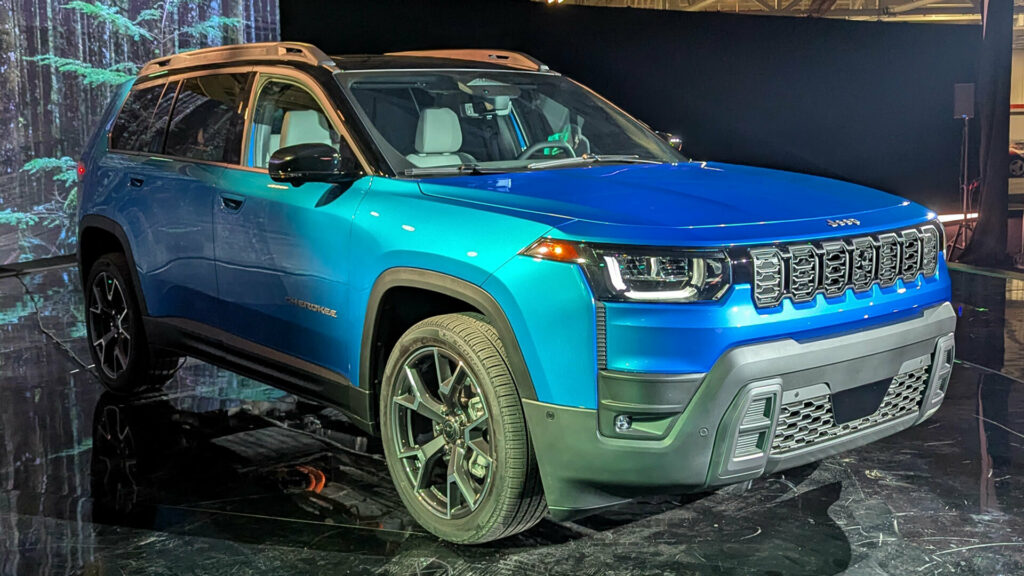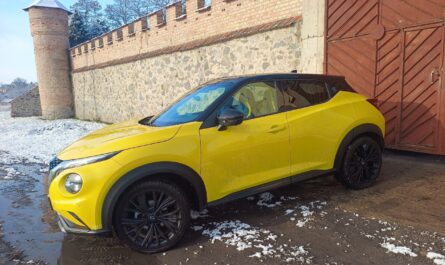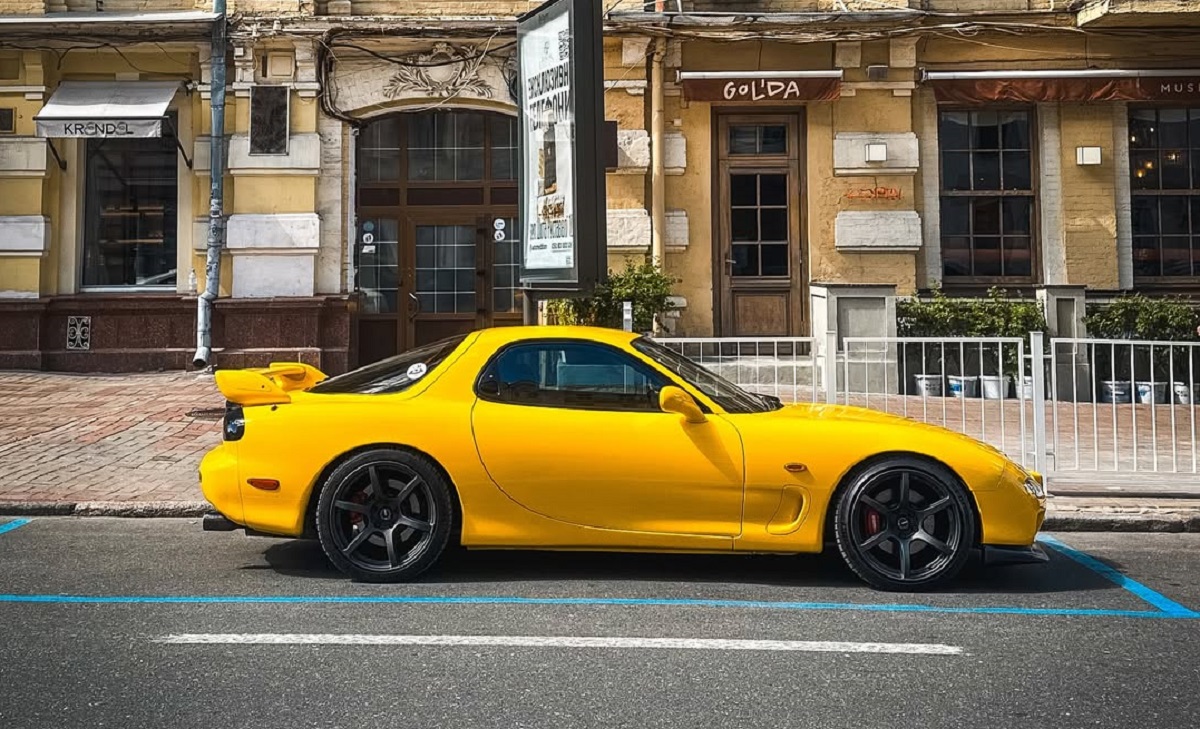The Return of the Jeep Cherokee in a New Form
Jeep has introduced the updated 2026 Cherokee model, which is set to debut later this year. The crossover received a completely new hybrid powertrain with 210 horsepower, becoming significantly larger than its predecessor and demonstrating fuel economy of 37 miles per gallon.
Exterior Design
The Cherokee returns larger and more refined, with efficiency thanks to the new hybrid system. The design combines ruggedness and elegance, making the model competitive in the hybrid crossover segment.
The exterior features a “super vertical” front end with a narrow grille and rectangular headlights reminiscent of the Cherokee XJ. The body has sharp lines and massive cladding.
Michael Gauthier / Carscoops
Designers also added a large glass roof and flush-mounted door handles. The model comes equipped with wheels ranging from 17 to 20 inches with Nexen Roadian GTX or Pirelli Scorpion MS tires.
The rear features stylized liftgate doors with a nod to the XJ in the form of familiar lines. The eyes are naturally drawn to the contrasting black taillights and the license plate frame inspired by canisters.
Dimensions and Space
The Cherokee has a length of 188.1 inches (4778 mm), a width of 83.6 inches (2123 mm), and a height of 67.5 inches (1715 mm) with a wheelbase of 113 inches (2870 mm). This makes the model 4.7 inches longer, 1 inch wider, and 2 inches taller than its predecessor. An additional 6.4 inches between the wheels ensures a more spacious cabin.
Elegant and Comfortable Interior
If the exterior looks sharp and modern, the luxurious interior follows the style of the Wagoneer S. Drivers get a square steering wheel and a 10.25-inch digital instrument cluster. It is complemented by a 12.3-inch Uconnect 5 infotainment system with wireless Android Auto and Apple CarPlay.
Michael Gauthier / Carscoops
Every Cherokee will have a ten-year subscription to Connect One, enabling over-the-air updates, automatic emergency calls, and connectivity with the Jeep app.
The cabin is open, bright, and minimalist. The center console is updated, with a rotary gear selector and a Selec-Terrain switch with Auto, Sport, Snow, and Sand/Mud modes.
Numerous buttons and knobs from the Cherokee KL have been removed, as the new model relies on the infotainment system. However, there are separate climate controls and a few buttons for vehicle functions. Even the door handles have been replaced with “digital latches”.
Despite the luxury, the Cherokee avoids leather in favor of the eco-friendly Capri material. It has unique perforation in the Overland version but does not replace genuine leather.
For sustainability, recycled materials are used in the headliner, carpets, and other elements.
Passenger Space
Despite the increased dimensions, second-row legroom has decreased from 40.3 to 38.5 inches. However, passengers gain an additional 2.5 inches of shoulder room and 5.2 inches of hip room.
Cargo volume has increased by 30%: 33.6 cubic feet behind the second row and 68.3 cubic feet behind the front seats, compared to 54.7 cubic feet in the previous model.
Jeep does not disclose trim details but mentions options such as heated and ventilated front seats, heated rear seats, a digital rearview mirror, a dual-pane sunroof, an Alpine audio system, and a power liftgate with kick activation.
Hybrid Powertrain
The model received a turbocharged 1.6-liter four-cylinder engine producing 177 horsepower and 221 lb-ft of torque. It is combined with a hybrid system that includes two electric motors, an electronically controlled continuously variable transmission (eCVT), and a 1.08 kWh lithium-ion battery.
The total output is 210 horsepower and 230 lb-ft of torque, significantly exceeding the figures of the old 2.4-liter engine.
Micky Bly, Head of Global Propulsion Systems at Stellantis: “Torque comes on early and stays flat.” He also noted that the powertrain has undergone thousands of miles of development and testing.
The hybrid system works with all-wheel drive and disconnection of the rear axle for efficiency, delivering 42 mpg in the city, 33 on the highway, and 37 combined.

Michael Gauthier / Carscoops
Jeep is excited about its first hybrid in America, but the Cherokee falls short of key competitors. The 2026 Toyota RAV4 has up to 236 hp, and the Hyundai Tucson Hybrid has 231 hp. The latter also offers up to 38 mpg combined.
The Cherokee is built on the STLA Large platform and has a towing capacity of 3500 pounds. The model’s weight has increased from 3875 to 4295 pounds.
Off-Road Potential
For off-roading, the model has an approach angle of 19.6°, a departure angle of 29.4°, and a breakover angle of 18.8°. Jeep notes that the approach and departure angles are best in class, along with 8 inches of ground clearance. This provides good capability, but serious off-roaders should wait for the Trailhawk version.
Standard features include driver assistance systems, including active driving assist that combines adaptive cruise control with lane centering. There is also intersection assist, parking assist with automatic braking, blind-spot monitoring with rear cross-path detection. Additionally available is a 360-degree camera system and blind-spot view when the turn signal is activated.
Pricing and Availability
The price of the 2026 Cherokee starts at $36,995, including a $1,995 destination charge. This is $2,035 more expensive than the Tucson Hybrid and $5,260 more than the Kia Sportage Hybrid. It will likely also be more expensive than the 2026 RAV4, as the previous hybrid started at $34,050.
Deliveries will begin late this year, with the Limited and Overland versions available first. The more affordable Cherokee and Laredo will appear in early 2026, all manufactured in Mexico.
Pricing Policy
The base Cherokee version costs $36,995, Laredo – $39,995, Limited – $42,495, and Overland – $45,995. All prices include the $1,995 destination charge.
The new Cherokee represents a significant step forward for Jeep, combining traditional ruggedness with modern eco-friendly solutions. Although prices are higher than some competitors, the model offers unique design, advanced technology, and an efficient hybrid system. Its success will depend on how consumers appreciate the balance between luxury, functionality, and sustainability.


 by
by 
